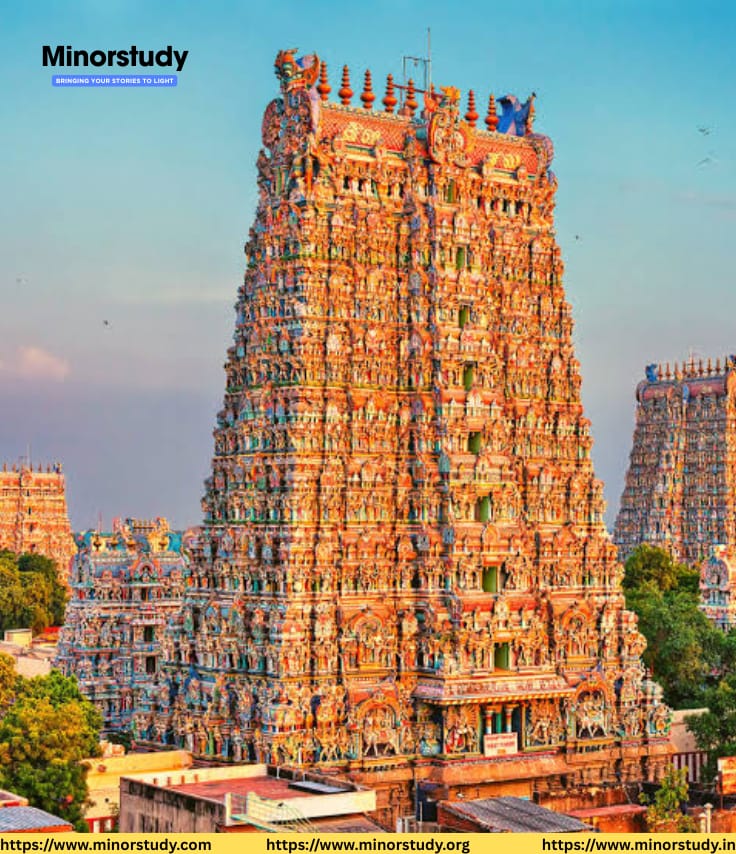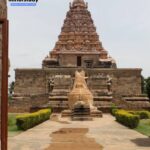🌸 Introduction: Meenakshi Amman Temple Where Divinity Meets Grandeur
In the heart of Tamil Nadu lies Madurai, one of India’s oldest living cities. At its spiritual and architectural center stands the Meenakshi Amman Temple, a symbol of feminine divine power, South Indian art, and devout Shaivite-Vaishnavite harmony.
- 🕰️ History of Meenakshi Amman Temple
- 📊 10 Fascinating Facts About Meenakshi Amman Temple
- 📜 Timeline of the Meenakshi Amman Temple
- ❓ Frequently Asked Questions (FAQs)
- Q1: Who is Meenakshi Amman?
- Q2: Why is Meenakshi Temple important?
- Q3: Where is it located?
- Q4: What is the Meenakshi Tirukalyanam?
- Q5: Is the temple open to tourists?
- 💫 Significance in Religion and Society
- 💝 Heartfelt Wishing
- 📌 Important Points to Remember
- 🧘 Daily Life Impacts
- 🌍 Importance to Society
- 🔚 Conclusion: A Timeless Testament of Devotion and Divinity
More than just a religious structure, it is a living temple, bustling with rituals, festivals, traditions, and millions of devotees. Its rich history, spiritual energy, and artistic brilliance make it one of the most venerated temples in India — and the world.
Let us take a soul-nourishing journey into the temple’s legacy, significance, cultural impact, and more.
🕰️ History of Meenakshi Amman Temple
The temple’s origin is deeply mythological and historical. According to legend, Goddess Meenakshi (an incarnation of Parvati) emerged from a sacred fire to rule Madurai and later married Lord Shiva in his form as Sundareswarar.
Historically, the original temple was likely built by the Pandya dynasty in the 6th century CE, and it was later expanded by various rulers, including:
🛕 12th–13th centuries: Pandyan rulers expand the sanctum and towers.
⚔️ 14th century: Malik Kafur, a commander of Alauddin Khilji, plunders Madurai; temple suffers damage.
🛕 16th century onwards: Tirumala Nayaka and other Nayak kings rebuild and restore the temple into its current form.
🛕 20th century: Renovations, conservation, and international recognition.
📊 10 Fascinating Facts About Meenakshi Amman Temple
🌈 14 Gopurams (Towers) – The temple complex has 14 towers, including the South Tower that rises 170 feet, richly sculpted and painted in bright colors.
🌺 33,000 Sculptures – The temple houses over 33,000 intricately carved sculptures, narrating mythology, history, and daily life.
🔱 Twin Sanctums – Unique among Indian temples, it has two main sanctums – for Meenakshi Devi and Sundareswarar (Shiva).
🌊 Golden Lotus Tank – Pilgrims take a holy dip in the sacred Porthamarai Kulam, believed to test purity.
📅 Meenakshi Tirukalyanam Festival – Celebrated in April–May, this celestial wedding attracts over 1 million devotees.
🛐 Continuous Worship for Centuries – The temple has had uninterrupted daily rituals for over 1000 years.
🎨 Architectural Wonder – It is a masterpiece of Dravidian architecture, showcasing carved pillars, musical halls, and mandapams.
🕉️ Spiritual Energy – Many say the temple radiates a unique feminine Shakti (energy) unlike anywhere else.
🪷 Museum Inside – The Thousand Pillar Hall functions as a museum showcasing South Indian heritage.
🌏 UNESCO Nomination – The temple is a proposed UNESCO World Heritage Site, recognized for cultural value.
📜 Timeline of the Meenakshi Amman Temple
| Year/Period | Event/Milestone |
|---|---|
| 6th century CE | First temple built by early Pandyas |
| 1310 CE | Invasion by Malik Kafur damages temple |
| 1560–1650 CE | Nayak kings rebuild and expand temple |
| 1960s | Restoration and archaeological preservation |
| Present Day | Major global pilgrimage and cultural site |
❓ Frequently Asked Questions (FAQs)
Q1: Who is Meenakshi Amman?
A: Meenakshi is a form of Goddess Parvati, worshipped primarily in Tamil Nadu as the warrior queen-goddess who married Lord Shiva in Madurai.
Q2: Why is Meenakshi Temple important?
A: It’s one of the few temples dedicated to a female deity and a center of Shaktism, Shaivism, and Vaishnavism, known for its spiritual energy, art, and rituals.
Q3: Where is it located?
A: In the temple city of Madurai, Tamil Nadu, India.
Q4: What is the Meenakshi Tirukalyanam?
A: It’s the grand wedding festival of Meenakshi and Sundareswarar, held during Chithirai month (April-May), with processions, rituals, and cultural shows.
Q5: Is the temple open to tourists?
A: Yes, tourists from around the globe visit it. However, only Hindus are allowed inside the main sanctum, while others can admire the outer architecture.
💫 Significance in Religion and Society
🔱 Religious Importance: The temple is one of the most sacred Shakti Peethas and a major Shaivite center.
🧘♂️ Spiritual Energy: Many devotees report a heightened sense of calm, clarity, and connection during their visit.
🎭 Cultural Hub: It has shaped classical music, Bharatanatyam dance, sculpture, and painting in South India.
🛕 Center of Feminine Power: A rare celebration of the Goddess as the primary deity, symbolizing strength, leadership, and compassion.
💝 Heartfelt Wishing
🕊️ May the grace of Goddess Meenakshi guide you through every challenge, illuminate your soul with wisdom, and bless you with strength and peace. Let her divine radiance fill your heart with eternal joy. 🌸🙏
📌 Important Points to Remember
✅ Temple complex spans over 15 acres
✅ Over 33,000 sculptures
✅ Worshipped by millions annually
✅ Hosts largest temple festival in South India
✅ Architectural mix of religion, art, and science
🧘 Daily Life Impacts
👪 Community & Culture
Serves as a unifying space for cultural festivals, marriages, and spiritual events.
Supports arts, crafts, dance, and music in surrounding areas.
💼 Economy & Tourism
Drives significant revenue through tourism, local businesses, and temple employment.
Provides livelihoods for priests, artisans, flower sellers, guides, and hoteliers.
🙏 Spiritual Influence
Helps people connect with tradition and inner peace in chaotic modern life.
Temple routines set daily rhythms for many families in Madurai.
🌍 Importance to Society
🛕 Cultural Preservation: A living museum preserving Tamil art, literature, and customs.
💓 Spiritual Resilience: Provides emotional and spiritual strength to devotees.
🌐 Global Recognition: One of the top spiritual destinations for international tourists.
🤝 Symbol of Unity: Demonstrates harmony between male and female divinity, myth and reality, local and global faith.
🔚 Conclusion: A Timeless Testament of Devotion and Divinity
The Meenakshi Amman Temple is not just a temple — it’s a heartbeat of Madurai, a beacon of feminine energy, and a guardian of India’s spiritual soul.
Its towering gopurams, bustling rituals, and mystical aura continue to inspire millions to seek, believe, and transform. Whether you are a pilgrim, a seeker, or a traveler, Meenakshi’s blessings touch all who enter her divine abode.








